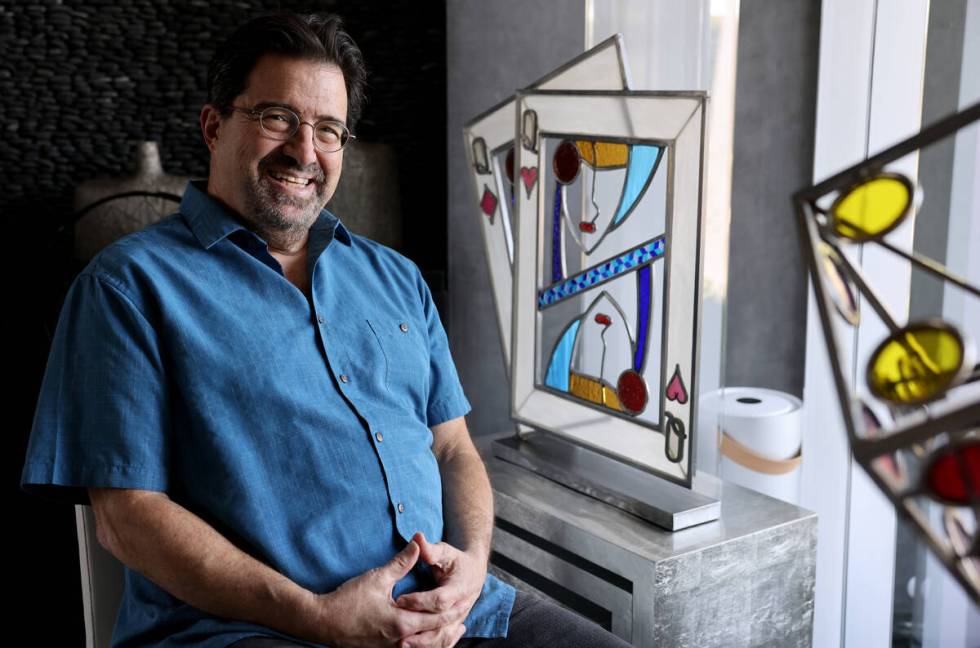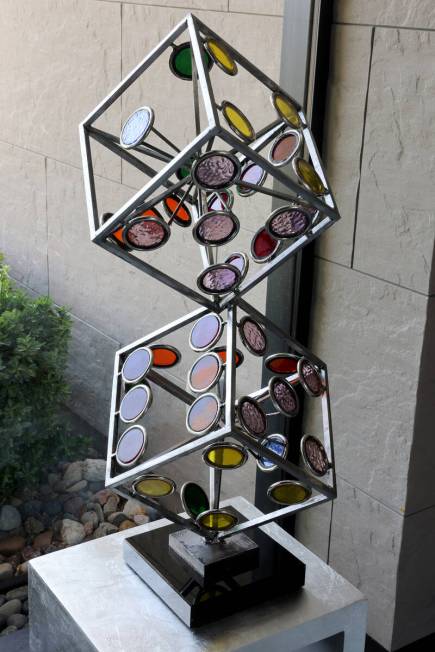Longtime attorney and UNLV professor finds joy as a sculptor
UNLV professor Anthony Cabot has authored or co-authored 12 books on gaming law during his 37-year career as an attorney. But the legal expert, who holds the title of distinguished fellow of gaming law at the William S. Boyd School of Law, has surprised even his closest friends with his ability to create sculptures.
“I always had an interest in art, but I never really thought of myself as someone who would produce art,” Cabot said in an interview at his Summerlin home, adorned with sculptures he has created.
It stands to reason that his desire to create art pieces is frequently inspired by the industry he has been a part of for his entire career.
A steel and stained-glass sculpture of a pair of dice was one of the first pieces his Facebook friends got to see. “Tumbling Dice” is about 33 inches tall and 18 inches wide and depicts a pair of dice attached corner-to-corner.
Another steel and glass sculpture, “Pocket Queens,” is a 26-by-32-inch piece featuring the image of a queen of hearts and a queen of diamonds.
He posts pictures of the sculptures on social media and waits for the reaction. It’s almost always affirming.
“People seem to enjoy it,” Cabot said. “I get good reactions. I use Facebook as a barometer of whether or not what I’m doing is in the right direction or not.”
An art expert contacted by the Review-Journal also had high marks, when shown images of Cabot’s pieces.
“They are thoughtful re-creations of familiar objects associated with the gaming industry,” said UNLV’s Director of Galleries Jerry Schefcik.
“They look to be well-crafted in a medium not typically used for three-dimensional objects. In a manner of thinking, stained glass is generally associated with houses of worship. If you wanted to stretch that thought a bit, gaming, in some regard, could be considered a worshipful activity in that much attention, thought, time, sacrifice and resources are given to it,” he said. “It is an activity that sustains life, especially in this state. So a connection between stained glass as religious markers and gaming is not so far fetched. Overall, I would call these pieces craft objects more so than art objects.”
Not for sale
Many of Cabot’s friends have wanted to buy his creations, but he has no desire to sell them.
“I’ll get 40 or 50 different comments about the work,” Cabot said. “People seem to like it. Shockingly to me, people have wanted to buy the pieces, which I tell them, ‘They aren’t for sale.’ I’m not doing this to make a living. I do it because I enjoy doing it. My job now is to be a professor, but I enjoy doing these things as a hobby.”
Becoming a professor helped create the path toward being an artist.
After Cabot received his Juris Doctor from Arizona State University, he joined former Gov. Grant Sawyer at Las Vegas’ Lionel Sawyer Collins law firm in 1981, one of the first firms to develop a gaming law practice in the city.
Working beside longtime mentor and friend Robert Faiss, Cabot carved his own niche in gaming law. He said as a student he wrote his own study guides, which led him to become a prolific writer of gaming law texts just as the concept of internet gambling was coming into its own in the late 1990s and early 2000s.
After about 25 years with Lionel Sawyer Collins, Cabot left to join the firm Lewis Roca Rothgerber Christie. He was there 12 years — working 56-hour weeks and raising a family. When he left in 2018 he took advantage of the perks of being a college professor.
Vacation started art journey
“The first thing I did was take a long vacation,” he said. “I never took more than a week and a half or two weeks off in 37 years.”
He went to Europe with his wife, daughter and her boyfriend, an accomplished artist, and discovered a sculpting class with an artist in Barcelona.
“One of the things about Europe is that in a lot of places (they) offer experiences,” he said.” So my daughter’s boyfriend and I decided to try a sculpting experience where you actually create a sculpture.”
He was hooked.
“It turned out to be a lot of fun. My sculpture wasn’t very good, but it was a first shot,” Cabot said.
He talked with his brother in Cleveland and decided to buy a welder, setting up shop in his garage. Then, it was a matter of coming up with ideas and executing them.
In addition to steel and stained glass, Cabot experimented with magnets. He tinkered with embedding magnets in a circular frame then placing other magnets on the ends of a chain. The artistic effect is that the magnetic forces attract each other and the chain appears to be suspended in midair.
When in Cleveland, Cabot came across a person at the Rock and Roll Hall of Fame who collected key cards from the hotels at which he stayed. Cabot had his own collection of key cards during his travels to foreign gaming jurisdictions.
“Something’s going to happen with these, but I don’t know what just yet,” he said.
He eventually was inspired to create a piece in the shape of a keyhole with the dozens of key cards he had collected, locking the cards in under epoxy.
‘Two Guitars’
Cabot was able to get better and better at creating his steel and stained glass art.
He created stained glass floral bouquets, cactus sculptures and even blended magnets. He’s also used stained glass and epoxy with a new element, wood, in his most recent piece “Two Guitars,” inspired by Pablo Picasso’s “Guitar” sculptures, first made of cardboard then later with sheet metal.
One of his art career highlights was being named the winner of a magazine art contest by Arizona Attorney magazine in May 2021.
Cabot says he finds inspiration in viewing the work of Picasso and French-artist Patrice Merot, surfing through Pinterest or just taking a walk through a casino.
“It’s kind of weird because I’ll go for a long time without having an idea,” he said. “Then all of a sudden, I’ll see something and go, ‘That’s interesting.’ ”
Some of his ideas show off his sense of humor. In one of his bathrooms, he displays “Lawyers Going to Work,” a metal piece showing shark fins emerging from an epoxy surface.
But ask Cabot about his favorite piece and he comes back to “Pocket Queens.”
“‘Queens’ was a three-month project and I put around 80 hours into it,” he said. “My glass cutting isn’t all that good. I went through a lot of broken glass before I got all of those pieces the way I wanted them to be. The nice thing about a lot of these pieces is that they took a long time, but they taught me a lot of skills and they taught me how to cut glass and weld and do epoxy boards and other techniques.”
Contact Richard N. Velotta at rvelotta@reviewjournal.com or 702-477-3893. Follow @RickVelotta on Twitter.



